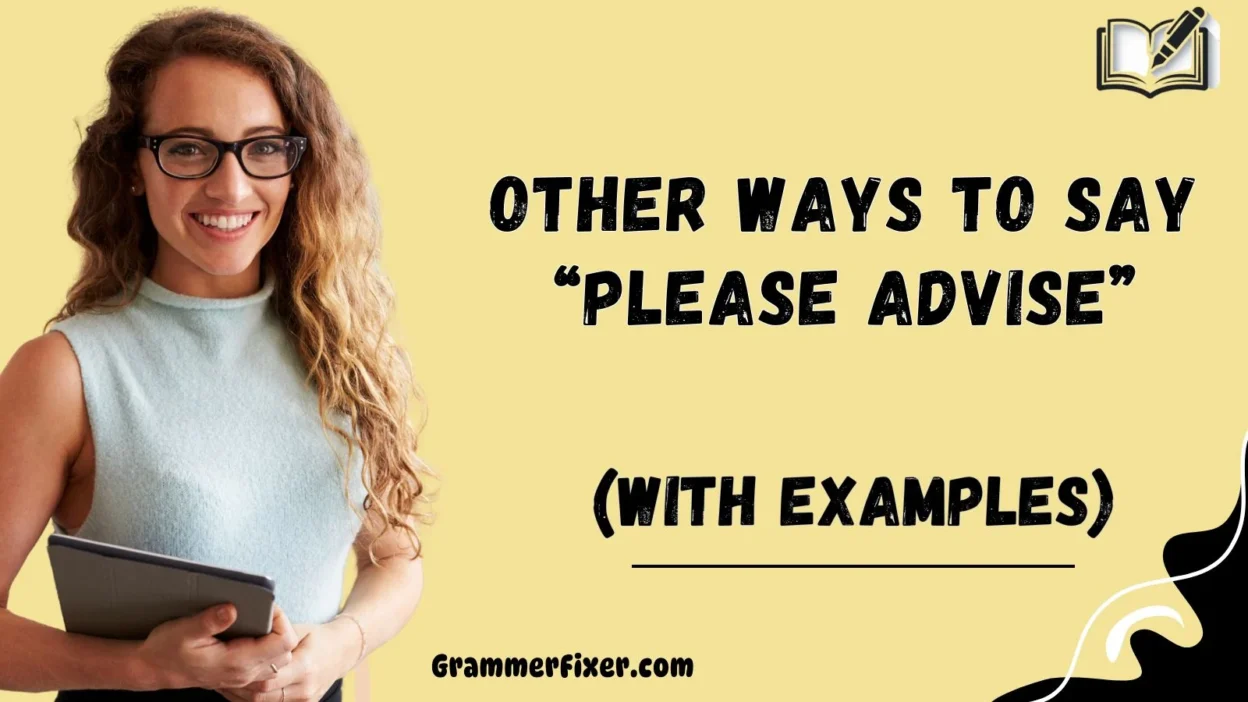Finding the right words in professional or personal communication can completely change the tone of your message. While “Please Advise” is a commonly used phrase, it can sometimes feel cold, stiff, or overly formal. By choosing warmer and more thoughtful alternatives, you can express care, respect, and clarity, making your message more engaging and considerate.
Below, we’ll explore 30 alternatives to “Please Advise” that can help you build stronger connections while keeping your communication professional.
What Does “Please Advise” Mean?
The phrase “Please Advise” is a short way of asking someone to provide guidance, direction, or feedback on a matter. It is often used in emails, letters, and workplace communication when the sender needs input, clarification, or a decision from the recipient.
When to Use “Please Advise”?
You can use “Please Advise” when:
- You are seeking someone’s guidance or input.
- You require clarity, direction, or a decision.
- You want to signal urgency or emphasize the importance of a matter.
It is most commonly used in professional settings, such as emails to managers, clients, or colleagues.
Is It Professional/Polite to Say “Please Advise”?
Yes, “Please Advise” is professional, but it can sometimes be interpreted as distant, curt, or transactional. It is better to use softer alternatives when you want to sound empathetic, approachable, or collaborative, especially in situations that involve teamwork, sensitive issues, or when you want to build rapport.
Pros or Cons of Using “Please Advise”
Pros:
- Clear and concise.
- Commonly understood in professional settings.
- Works well in formal or legal communication.
Cons:
- Can sound cold, impersonal, or commanding.
- May lack warmth and collaboration.
- Can feel overused or outdated.
1. May I Have Your Guidance?
Meaning: A respectful way of asking for someone’s expertise or advice.
Detailed Explanation: This phrase conveys humility and politeness, making it ideal when reaching out to superiors or mentors.
Scenario Example: “May I have your guidance on how best to approach this client proposal?”
Best Use: Formal workplace settings, mentorship requests.
Worst Use: Casual chats or quick team updates—it may sound overly formal or stiff.
Tone: Polite, respectful, professional.
2. Could You Provide Specific Instructions?
Meaning: A direct request for step-by-step guidance.
Detailed Explanation: This phrase helps when you are unsure of the exact steps and need detailed clarity.
Scenario Example: “Could you provide specific instructions for submitting the revised report?”
Best Use: Workplace tasks, assignments, or project details.
Worst Use: Brainstorming or creative discussions—it can feel rigid and overly procedural.
Tone: Clear, professional, instructional.
3. I Would Appreciate Your Input
Meaning: A warmer way to ask for someone’s thoughts or recommendations.
Detailed Explanation: This phrase highlights gratitude and collaboration rather than formality.
Scenario Example: “I would appreciate your input on the marketing strategy before we finalize it.”
Best Use: Collaborative projects, brainstorming sessions.
Worst Use: High-pressure or urgent situations—it may feel too soft and non-urgent.
Tone: Appreciative, inviting, thoughtful.
4. Could You Share Your Perspective?
Meaning: Requests someone’s viewpoint or insights.
Detailed Explanation: This phrase encourages open dialogue and values diverse perspectives.
Scenario Example: “Could you share your perspective on how this change may affect the team?”
Best Use: Group discussions, decision-making.
Worst Use: Time-sensitive instructions—it might delay action if too many perspectives are invited.
Tone: Inclusive, open, conversational.
5. Kindly Keep Me Updated
Meaning: A polite way to ask for ongoing updates or progress reports.
Detailed Explanation: Instead of requesting immediate advice, this phrase ensures you remain in the loop.
Scenario Example: “Kindly keep me updated on the regulatory changes as they occur.”
Best Use: Long-term projects, ongoing communication.
Worst Use: Casual peer conversations—it can sound stiff and unnecessarily formal.
Tone: Courteous, respectful, professional.
6. Let Me Know Your Thoughts
Meaning: A casual, approachable way to request feedback.
Detailed Explanation: This phrase feels friendlier and less formal, making it suitable for colleagues or peers.
Scenario Example: “Let me know your thoughts on the new campaign design.”
Best Use: Everyday workplace communication, informal collaboration.
Worst Use: Formal emails to senior management—it may come across as too casual or even dismissive.
Tone: Friendly, casual, approachable.
7. Looking Forward to Your Response
Meaning: Expresses anticipation and politeness while waiting for feedback.
Detailed Explanation: This phrase shows optimism and courtesy, keeping the tone positive while expecting a reply.
Scenario Example: “Looking forward to your response regarding the updated proposal.”
Best Use: Professional emails where you want to show respectful anticipation.
Worst Use: When urgent action is required—it might sound too patient and not stress the urgency.
Tone: Positive, polite, respectful.
8. Please Inform Me at Your Earliest Convenience
Meaning: A polite way to ask for a response without sounding demanding.
Detailed Explanation: This phrase balances professionalism and courtesy, making it suitable when timing matters but you don’t want to sound urgent.
Scenario Example: “Please inform me at your earliest convenience if the meeting schedule has changed.”
Best Use: Client communication, manager updates, professional email correspondence.
Worst Use: Informal or casual chats—it may sound too formal and heavy-handed.
Tone: Polite, professional, considerate.
9. Can You Help Clarify?
Meaning: Requests explanation or further detail in a respectful way.
Detailed Explanation: This phrase is excellent when something is unclear or confusing, and you want to avoid assumptions.
Scenario Example: “Can you help clarify the requirements for the next phase of the project?”
Best Use: Situations with ambiguity, unclear tasks, or technical instructions.
Worst Use: When the recipient has already explained thoroughly—it may come across as inattentive.
Tone: Respectful, approachable, inquisitive.
10. I’d Be Grateful for Your Insights
Meaning: A warm and appreciative way of asking for someone’s knowledge or viewpoint.
Detailed Explanation: This phrase conveys gratitude before receiving help, which can make the recipient feel valued.
Scenario Example: “I’d be grateful for your insights on how we can improve our engagement strategy.”
Best Use: Seeking expertise from mentors, consultants, or senior colleagues.
Worst Use: Fast-paced urgent tasks—it might sound too formal and slow for quick answers.
Tone: Appreciative, respectful, collaborative.
11. Kindly Advise on This Matter
Meaning: A slightly softer version of the original phrase “Please Advise”.
Detailed Explanation: Adding “Kindly” makes the request sound more polite and less commanding.
Scenario Example: “Kindly advise on this matter so we can finalize the contract.”
Best Use: Formal business emails, especially with clients or external partners.
Worst Use: Casual team updates—it may sound stiff or overly formal.
Tone: Polite, formal, professional.
12. Could You Give Me Your Recommendation?
Meaning: A respectful way of requesting suggestions or preferred solutions.
Detailed Explanation: This phrase works best when you want direction based on someone’s expertise.
Scenario Example: “Could you give me your recommendation on which vendor we should proceed with?”
Best Use: Decision-making, seeking expert advice.
Worst Use: Everyday small issues—it may sound too weighty for minor topics.
Tone: Respectful, thoughtful, professional.
13. Do You Have Any Suggestions?
Meaning: An open-ended request for ideas or input.
Detailed Explanation: This phrase invites collaboration and allows multiple solutions to surface.
Scenario Example: “Do you have any suggestions for improving the design layout?”
Best Use: Brainstorming, creative sessions, collaborative environments.
Worst Use: Formal business decisions—it may come across as too casual or imprecise.
Tone: Friendly, approachable, collaborative.
14. Could You Assist with This?
Meaning: A polite request for help or support.
Detailed Explanation: This phrase is a direct but courteous way to involve someone in a task or issue.
Scenario Example: “Could you assist with updating the financial report before tomorrow’s meeting?”
Best Use: Task-oriented emails, workplace assignments.
Worst Use: Requests that fall outside the recipient’s role—it may feel inappropriate or pushy.
Tone: Respectful, professional, collaborative.
15. Please Keep Me in the Loop
Meaning: A conversational way to ask for continuous updates and inclusion.
Detailed Explanation: This phrase is less formal but engaging, showing you want to stay informed.
Scenario Example: “Please keep me in the loop as the negotiations progress.”
Best Use: Ongoing projects, team collaborations, casual professional settings.
Worst Use: Formal communication with high-level executives—it can sound too casual.
Tone: Friendly, approachable, collaborative.
16. Could You Point Me in the Right Direction?
Meaning: A friendly way to ask for guidance or next steps.
Detailed Explanation: This phrase feels natural and conversational, while still respectful. It works well when you’re a bit uncertain but don’t want to sound overly formal.
Scenario Example: “Could you point me in the right direction regarding which software we should use for this analysis?”
Best Use: Workplace collaboration, informal guidance.
Worst Use: High-stakes or legal communication—it can sound too casual.
Tone: Friendly, approachable, respectful.
17. I’d Love to Hear Your Thoughts
Meaning: An inviting way to ask for someone’s opinion or feedback.
Detailed Explanation: This phrase carries warmth and openness, making the recipient feel that their voice is valued.
Scenario Example: “I’d love to hear your thoughts on the revised project outline.”
Best Use: Team collaboration, creative brainstorming, peer discussions.
Worst Use: Serious corporate or legal contexts—it may feel too casual or emotional.
Tone: Warm, inviting, collaborative.
18. Could You Clarify This for Me?
Meaning: A polite way to request explanation or simplification.
Detailed Explanation: It shows that you are engaged and willing to understand, without sounding demanding.
Scenario Example: “Could you clarify this section of the report for me before I present it?”
Best Use: Workplace communication, academic contexts, detailed reports.
Worst Use: Informal conversations—it may sound overly stiff.
Tone: Respectful, professional, inquisitive.
19. I Value Your Opinion
Meaning: A phrase that acknowledges and appreciates someone’s judgment or expertise.
Detailed Explanation: It demonstrates respect and gratitude, encouraging open and collaborative communication.
Scenario Example: “I value your opinion on whether this proposal aligns with our company’s goals.”
Best Use: When seeking advice from senior colleagues, mentors, or experts.
Worst Use: Urgent matters—it may sound too leisurely and non-urgent.
Tone: Appreciative, respectful, collaborative.
20. Could You Weigh In?
Meaning: A casual phrase asking someone to share their viewpoint.
Detailed Explanation: It’s short, simple, and works well in collaborative settings where you want to invite participation.
Scenario Example: “Could you weigh in on the discussion about the new product features?”
Best Use: Team meetings, collaborative discussions.
Worst Use: Formal emails or legal documents—it can sound too casual or slang-like.
Tone: Friendly, casual, approachable.
21. Please Share Your Feedback
Meaning: A direct request for constructive comments or evaluations.
Detailed Explanation: This phrase is professional and open, encouraging a recipient to contribute meaningfully.
Scenario Example: “Please share your feedback on the draft presentation before tomorrow.”
Best Use: Work projects, academic reviews, creative submissions.
Worst Use: Informal peer chats—it can sound overly formal.
Tone: Professional, open, collaborative.
22. Could You Offer Your Advice?
Meaning: A softer alternative to “Please Advise”.
Detailed Explanation: By asking someone to “offer,” you invite collaboration rather than demand direction.
Scenario Example: “Could you offer your advice on handling this client’s concerns?”
Best Use: Client relations, managerial discussions, professional consultations.
Worst Use: Simple updates or quick tasks—it may sound too heavy-handed.
Tone: Polite, respectful, collaborative.
23. I’m Seeking Your Guidance
Meaning: Expresses humility and shows that you are open to learning or direction.
Detailed Explanation: This phrase highlights respect for the recipient’s experience and knowledge.
Scenario Example: “I’m seeking your guidance on how to proceed with the conflict resolution.”
Best Use: Formal communication with mentors, managers, or consultants.
Worst Use: Everyday workplace exchanges—it can sound unnecessarily formal.
Tone: Humble, respectful, professional.
24. Could You Help Me Understand?
Meaning: A gentle way to request clarification or explanation.
Detailed Explanation: It positions the request in a collaborative and non-demanding way.
Scenario Example: “Could you help me understand the reasoning behind this policy change?”
Best Use: Sensitive discussions, when seeking clarity without confrontation.
Worst Use: Strictly urgent matters—it may come across as too soft.
Tone: Gentle, respectful, collaborative.
25. Please Let Me Know How to Proceed
Meaning: A straightforward request for next steps or instructions.
Detailed Explanation: This phrase is ideal when you’re waiting for direction before continuing with a task.
Scenario Example: “Please let me know how to proceed with the revised contract.”
Best Use: Project updates, task completion, formal professional emails.
Worst Use: Creative brainstorming—it may sound too directive or procedural.
Tone: Clear, professional, respectful.
26. I’d Appreciate Your Recommendation
Meaning: A warm and respectful way of asking for someone’s preferred course of action.
Detailed Explanation: This phrase conveys gratitude and trust in the recipient’s judgment.
Scenario Example: “I’d appreciate your recommendation on which design we should finalize.”
Best Use: Decision-making, expert consultations.
Worst Use: Informal or minor matters—it may sound overly formal.
Tone: Appreciative, respectful, professional.
27. Could You Guide Me Through This?
Meaning: A request for step-by-step support or mentorship.
Detailed Explanation: This phrase is supportive and collaborative, useful when you need hands-on help.
Scenario Example: “Could you guide me through the process of preparing the tax documents?”
Best Use: Learning tasks, training, mentorship.
Worst Use: Quick or small tasks—it may sound like an over-commitment.
Tone: Supportive, collaborative, respectful.
28. I’d Be Thankful for Your Advice
Meaning: A grateful and polite way of asking for someone’s input or direction.
Detailed Explanation: Similar to “I’d appreciate your advice”, but carries a warmer tone of gratitude.
Scenario Example: “I’d be thankful for your advice on resolving this client’s concerns.”
Best Use: Professional but cordial communication, especially with valued colleagues.
Worst Use: High-level executive discussions—it may sound too emotional.
Tone: Grateful, warm, polite.
29. Please Help Me Resolve This
Meaning: A request for direct assistance in solving a problem.
Detailed Explanation: This phrase is more urgent and emphasizes collaboration in problem-solving.
Scenario Example: “Please help me resolve this issue with the supplier contract.”
Best Use: Problem-solving, urgent workplace issues, conflict resolution.
Worst Use: Routine updates or non-serious matters—it may sound overly dramatic.
Tone: Urgent, collaborative, respectful.
30. Could You Provide Your Viewpoint?
Meaning: A formal way to request someone’s perspective on an issue.
Detailed Explanation: This phrase conveys professionalism and invites thoughtful contributions.
Scenario Example: “Could you provide your viewpoint on the upcoming policy changes?”
Best Use: Formal meetings, policy discussions, strategic planning.
Worst Use: Informal chats with peers—it may sound too stiff.
Tone: Professional, formal, respectful.
Conclusion
While “Please Advise” has long been a staple in professional emails, it often comes across as stiff, overly formal, or impersonal. By using these 30 alternatives, you can bring more warmth, clarity, and respect into your communication. Each option carries its own tone—some are formal and precise, others are friendly and approachable—giving you the flexibility to choose what best fits the situation, urgency, and relationship.



